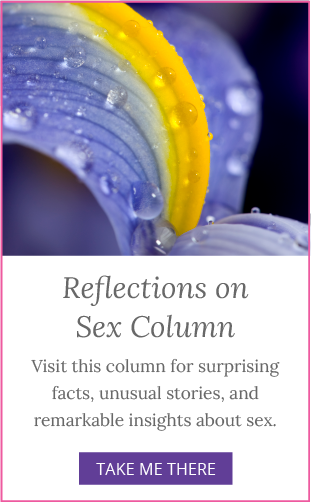Learning about Healthy Sex and Sexual Loving
Sex is one of the nine reasons for reincarnation. The other eight are unimportant.
HENRY MILLER
Sex & Love Table of Contents

What is healthy sexuality?
Whether you’re into kink or conventional sex, there’s lots to learn if you want to be a sexually healthy person and have sexually healthy relationships. Sex is a powerful, very natural force in our lives. But like any natural force we encounter – be it wind, rain, sun or our own laughter – our sexual energy has the potential to be channeled and experienced in either destructive or life-affirming ways.
In healthy sex you approach sex with conscious intention. You actively choose to express your sexual energy in ways that enhance your and your partner’s self-esteem, physical health, and emotional well-being. Healthy sex is safe, respectful, responsible, consensual, and mutually pleasurable. You have fun, play fair and nobody gets hurt.
Learning the principles and skills necessary for achieving healthy sex in today’s world is not easy. It can feel like we’re swimming against a tidal wave of sexual misinformation, demeaning erotic images, over-stimulating materials, and cheap role models, that are intent on taking our sexual energy in another direction. Much of the sex we are exposed to over the Internet, in movies, on television, in books and in magazines, is impulsive, irresponsible, impersonal, and uncaring. And many of us never received an adequate sex education to prepare us with accurate information about sexual basics – such as how our bodies and sexual organs work, how to ensure sexual pleasure, and how to protect against undesirable outcomes. (Take our Sexual Health Risks Checklist to test your knowledge and/or see our Links page for listings of trustworthy sex education organizations and websites)
We may also have a hard time conceptualizing healthy sex because we have already experienced some tragic consequences of poorly channeled sexual energy. Rates of sexual abuse, sexual compulsion/addiction, porn problems, sexual exploitation, sexually transmitted disease, unwanted pregnancy, and sexual functioning problems, are high. (Check out the comparison charts in our article How Do You Think about Sex? to see the many ways healthy sex differs from abuse and addiction-driven sex.)
But healthy sex is possible to learn regardless of our past exposures and experiences. An education in healthy sexuality starts with the awareness that it is up to you to design and go after the type of sexual life and experiences you want for yourself. No one can do it for you. If you want to have a sex life based on healthy sex principles and behaviors you can learn what’s necessary and make it happen.
Choosing healthy sexuality
Steering yourself on a healthy sexuality course involves acquiring new knowledge and skills, as well as knowing how to avoiding pitfalls and problems. On a basic bodily level, it is important to become educated about the physical aspects of sex, such as sexual body parts, biology, hormones, functioning, and pleasuring techniques. This includes understanding reproduction, birth control, and other safe sex and disease prevention practices. You have to be aware of and be able to avoid all the common ways sexual activity can cause harm and be motivated and have the knowledge and resources you need to prevent it.
On a basic relationship level, healthy sexuality involves basic skills for being able to communicate honestly and negotiate with a partner about sex. You need to know how to form a relationship, establish consent, create trust, and communicate your sexual likes, dislikes, and needs. And these skills matter whether you are pursuing casual sex or are involved in a long-term committed relationship. Like with driving a car, in sex activity you need to know how to start, stop, shift speeds, and change direction according to what is happening in the moment. Everyone’s sexual turn-ons and turn-offs can be very different. Disruptions, disagreements, and disappointments are bound to happen from time to time. Succeeding in healthy sex practices means being able to handle the bumps in the road with patience and understanding.
It takes time to develop a healthy sex lifestyle. We recommend a simple acronym called CERTS as a mental reminder and short cut for staying focused on honoring the conditions that make it possible. C stands for consent, E is for equality, R is for respect, T is for trust, and S is for safety. When you are considering engaging in sex, you might ask yourself about each CERTS condition, one-by-one, if they are mutually present. If you can mentally check them all – ensuring there is consent, equality, respect, trust and safety – you’re good to go. Your sexual activity will conform to healthy sex principles and have a low risk for unpleasant outcomes.
If a CERTS condition is missing, you might ask yourself if there is something you could do to secure it. So, for example, if sex doesn’t feel “S” safe, would getting checked out and cleared for diseases first, using protection, or discussing what behaviors are okay or off-limits first, help establish it? Learn more about the CERTS Conditions for Healthy Sexuality here. (And check out our Sex & Love Library on this page for more articles and other resources for learning about healthy sexuality.)
Being able to channel your sexual energy in a positive, healthy direction makes for a happy sex life. And what makes it really awesome and worthwhile is that healthy sex practice builds a wonderful foundation for exploring sexuality in many styles and forms – for example, as a way of expressing and deepening love with someone special to you.
Taking sex to another level – connecting it with love
Sexual interaction takes on new dimensions when it moves beyond the physical experience of mutual pleasuring, sharing, healthy sport, and basic human connection to an experience of genuine loving. Sex with love is often described as meaningful, even spiritual. Sexual sensations and pleasuring become a dynamic way for expressing feelings of deep caring and appreciation for a partner. A caress says “you matter to me” and a conversation says “your emotional feelings and comfort take precedence over whatever physical activity we chose to do.” This is heart-centered sex. It can be felt momentarily or color the whole sexual experience that is being shared.
In heart-centered sex, making love actually makes love. An emotional connection is formed that can be built on and expanded with subsequent experiences. Through this love-based intimacy, we express genuine emotion, grow psychologically, and deepen a bond with another human. Our minds and bodies are not in it just for the moment or primarily for an orgasmic release, but we feel committed to continued pleasure and finding ways to keep connection strong and sexy into the future.
While love-based sex may not be everyone’s goal in every relationship, people who experience it tout its many pleasures and benefits. Coupled with love, sex can feel more relaxed, safe, meaningful, and special. Couples enjoy getting to know each other’s sexual preferences and rhythms, and developing a sexual history together, with shared and treasured sexual memories. It’s not unusual for people in love-based sexual relationships to develop their own language for expressing affection and discussing sex parts and activities. Like explorers in the wild, they build trust and form bonds out of sharing sensual adventures and discovering new things about each other together.
Describing what heart-centered sex looks and feels like is so personal it is often difficult to express or share. Like dancing, singing, or meditating, it is a felt experience. Literary descriptions and erotic art sometimes can come close. Famous quotations may give a brief glimpse. Poetry, with its universal language, concentrated and intense word power, and ability to mix physical sensation with emotional experience, can come even closer.
Love-based sex recognizes the natural ebb and flow of sexual desire and satisfaction. If a particular experience isn’t that great (as happens to everyone), it is not a big deal. Partners may feel disappointed and/or frustrated, but, given the focus on loving, they can more easily brush it off knowing there will be opportunities to connect physically in the future. Mutual laughter, playfulness, and acceptance save the day. Because conditions such as mutual consent, equality, respect, trust, and safety are already secured, love-based sexual partners often feel a freedom to explore new activities and sensations, without worry about being judged or having to perform a certain way.
The situation and skills necessary for love-based sex are not easy to accomplish. This form of sexual expression requires being in a good relationship and having a partner who is committed to it, as well. You both have to be open to cultivating and affirming love, of your partner, and of yourself. An enjoyable, love-based sexual relationship involves having the knowledge and ability to go beyond sexual pleasuring and safety skills and become really good at establishing and maintaining trust, communicating well in bed and out, and embracing images and inspirations that support healthy sex principles and keep sex alive, creative, and richly-rewarding over time. Poet Amy Lowell reminds us that heart-centered sex is a worthy goal: “Sexual love is the most stupendous fact of the universe, and the most magical mystery our poor blind senses know.”
Featured Sex and Love Resources
Wendy’s work on the topic of sex and love is vast and inclusive. To make it easy for you to begin to learn more, feel free to explore the sample of featured resources below. For a deeper understanding of sex and love, both by themselves and as they intersect, more readings, recordings, exercises, and inspirations are listed – and just a click away – in the “Sex & Love Library.”







